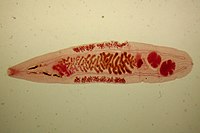
Photo from wikipedia
Abstract Abstract The foodborne liver trematode Opisthorchis felineus (Rivolta, 1884) is a member of the triad of phylogenetically related epidemiologically important Opisthorchiidae trematodes, which also includes O. viverrini (Poirier, 1886)… Click to show full abstract
Abstract Abstract The foodborne liver trematode Opisthorchis felineus (Rivolta, 1884) is a member of the triad of phylogenetically related epidemiologically important Opisthorchiidae trematodes, which also includes O. viverrini (Poirier, 1886) and Clonorchis sinensis (Loos, 1907). Despite similarity in the life cycle, Opisthorchiidae liver flukes also have marked differences. Two species (O. viverrini and C. sinensis) are recognized as Group 1A biological carcinogens, whereas O. felineus belongs to Group 3A. In this review, we focus on these questions: Are there actual differences in carcinogenicity among these 3 liver fluke species? Is there an explanation for these differences? We provide a recent update of our knowledge on the liver fluke O. felineus and highlight its differences from O. viverrini and C. sinensis. In particular, we concentrate on differences in the climate of endemic areas, characteristics of the life cycle, the range of intermediate hosts, genomic and transcriptomic features of the pathogens, and clinical symptoms and morbidity of the infections in humans. The discussion of these questions can stimulate new developments in comparative studies on the pathogenicity of liver flukes and should help to identify species-specific features of opisthorchiasis and clonorchiasis pathogenesis.
Journal Title: Parasitology
Year Published: 2022
Link to full text (if available)
Share on Social Media: Sign Up to like & get
recommendations!